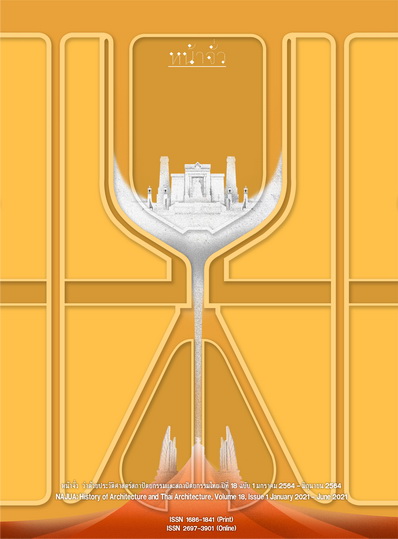Article Review: Public Space, Cultural Space and Public Cultural Space
Main Article Content
Abstract
A study about public and cultural spaces in terms of definition, meaning, and characteristic are numerous. Generally speaking, the public and cultural spaces are defined as everyone’s area. There is an interrelation between people and the area where everyone can use it freely and belong rightfully to both government and private sectors. However, it is still unclear about the overlapping meaning of public space and cultural space. This article explores the importance of culture in public spaces concerning ethnic groups, beliefs, and traditions. Literature review on the subject provides a better understanding of the overlapping meaning and more precise definition of the terms public cultural space, which will be helpful for further study.
Downloads
Article Details

This work is licensed under a Creative Commons Attribution-NonCommercial-NoDerivatives 4.0 International License.
References
Anan Ganjanpan, “khwāmkhaočhai watthanatham nai ngānwičhai sangkhom Thai [Culture understanding in Thai society research].” In mānutsayawitthayā patha watthanatham sưksā [Anthropological vs Culture study], 10-121. Bangkok: Princess Maha Chakri Sirindhorn Anthropology Centre, 2009.
Apisak Fhaithakam. “nǣothāng kānphatthanā phư̄nthī wāng sāthārana samrap chumchon mư̄ang : kō̜ranī sưksā mư̄ang Khō̜n Kǣn [The open space development guidelines for urban communities: A case study of Khonkaen city].” Master Thesis,
Chulalongkorn University, 2000.
Arkin Rapeepat. watthanatham khư̄ khwāmmāi: thritsadī læ withīkān khō̜ng khlipfō̜t kīasa [Culture is Meaning: Clifford Geertz Theory]. Bangkok: Princess Maha Chakri Sirindhorn Anthropology Centre, 2008.
Ministry of Culture. phǣn mǣbot watthanatham hǣng chāt Phō̜.Sō̜. [National cultural master plan 2007-2016]. Bangkok: Office of the Permanent Secretary for Culture, 2009.
Pranom Tansukanun and Monsicha Bejrananda. phư̄nthī sāthārana nai mư̄ang: chīwit mư̄ang Khō̜n Kǣn [A search for vital public spaces: The urban life of Khon Kaen]. Khon Kaen: Faculty of Architecture, Khon Kaen University, 2007.
Pranom Tansukanun and Wittaya Daungthima. nǣothāng kānphatthanā khwāmpen yān lāk miti khō̜ng mư̄ang Chīang Mai [The multi-layered districts of Chiang Mai city]. Chiang Mai: Maejo University, 2012.
Sant Suwatcharapinun. wādūai thritsadī thāng sathāpattayakam phư̄nthī sāthārana læ phư̄nthī thāng sangkhom Towards architectural theories: public space social]. Chiang Mai: Chiang Mai University Press, 2014.
Srisak Wallipodom. rư̄an Thai bān Thai [Tradition Thai House]. Bangkok: Ancient Town, 2000.
Supayada Praditvaitayakorn. “phư̄nthī sāthārana [Public Space].” Master thesis, Silpakorn University, 2012.
Yongyut Buranachareonkit, krabūankān sāng tō̜rō̜ng khwāmmāi khō̜ngwat nai thāna thī pen phư̄nthī thāng sangkhom: kō̜ranī sưksā wat pathum khongkhā læ wat trai mit witthayā rām [Wat' as social space: Processes of construction and contest meanings]. Bangkok: Thammasart University, 2002.
Sources (Other languages)
Carr, Stephen and others. Public space. New York: Cambridge University Press, 1995.
Featherstone, Mike. Consumer culture and postmodernism. London: SAGE, 1992.
Fiske, John. Understanding popular culture. Boston: Unwin Hyman, 1989.
Foucault, Michel. The order of things: An archeology of the human science. London: Tavistock Publications Limited, 1970.
Geertz, Clifford. The interpretation of cultures. New York: Basic Books, 1973.
Gehl, Jan. Life between buildings: Using public space. New York: Van Nostrand Reinhold, 1987).
Habermas, Jurgen. The structural transformation of the public sphere: An inquiry into a category of bourgeois society. Translated by Thomas Burger and Frederick Lawrence. Cambridge: MIT Press, 1989.
Jacobs, Jane. The death and life of great American cities. New York: MIT Press, 1960.
Leach, Neil, ed. Rethinking architecture: A reader in cultural theory. London: Routledge, 1997.
Lefebvre, Henri. The production of space. Translated by Donald Nicholson-Smith. Oxford: Blackwell, 1991.
Lynch, Kevin. A theory of good city form. Cambridge: MIT Press, 1981.
Newman, Oscar. Defensible space: Crime prevention through urban design. New York: Macmillan, 1972.
Norberg-Schulz, Christian. Existence, Space and Architecture. London: Studio Vista Limited, 1971.
Rapoport, Amos. Human aspects of urban form: Towards a man environment approach to urban form and design. Oxford: Pergamon Press, 1977.
Shone, Anton and Bryn Parry. Successful event management: A practical handbook. London: Thomson, 2004.
Soja, Edward. Thirdspace: Journeys to Los Angeles and other real and imagined places. Cambridge, Massachusetts: Blackwell, 1996.
Thompson, Bill. “Hermeneutics for architects?.” The Journal of Architecture 12, 2 (2007): 183-191.
Tylor, Edward Burnett. Primitive culture. London: John Murray, 1871.
Vernez-Moudon, Anne. Public streets for public use. New York: Colombia University Press, 1991.
Williams, Raymond. The sociology of culture. Chicago: The University of Chicago Press, 1981.
Yoshimi, Shunya. Toshi shakaigaku no furontia [The frontiers of urban sociology]. Tokyo: Nikhon Hyoronsha, 1992.


